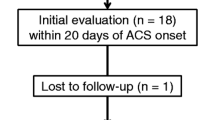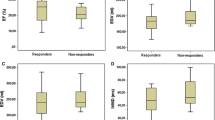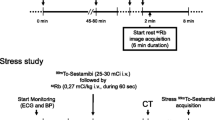Abstract.
Reduced regional technetium-99m methoxyisobutylisonitrile (99mTc-MIBI) accumulation in patients with chronic non-Q-wave infarction (NQWI) but without significant coronary artery stenosis indicates non-transmural damage of the myocardial wall. The aim of this study was to characterise cardiac energy metabolism after NQWI using phosphorus-31 magnetic resonance spectroscopy (31P-MRS) and to compare the biochemical remodelling with changes in regional 99mTc-MIBI uptake and with morphological and functional parameters assessed by magnetic resonance imaging (MRI). Fifteen patients with a history of NQWI, exclusion of significant coronary artery stenosis (<50% diameter stenosis) and hypokinesia of the anterior wall (group A) were examined with 31P-MRS to study the effects of NQWI on myocardial energy metabolism. Spectroscopic measurements were performed in the infarct-related myocardial region. Corresponding gradient-echo MR images and myocardial 99mTc-MIBI single-photon emission tomography images were acquired for exact localisation of the infarct region. All examinations were performed at rest under anti-ischaemic medication. Data were compared with those of patients in whom coronary artery disease had been excluded by angiography (group B, n=10). All patients of group A displayed anterior wall hypokinesia in the infarcted area on both ventriculography and MRI, with a reduced myocardial accumulation of 99mTc-MIBI (66.3%±11.8% vs 95.6%±2.2% in group B). The mean wall thickness during the complete cardiac cycle (9.5±1.8 mm vs 13.1±1.1 mm in group B, P<0.001), the systolic wall thickening (2.6±1.4 mm vs 5.8±1.5 mm in group B, P<0.01) and the phosphocreatine/adenosine triphosphate ratio (1.12±0.22 vs 1.74±0.23 in group B, P<0.01) in the hypokinetic area were all significantly reduced. It is concluded that persisting hypokinetic myocardium after NQWI combined with reduced myocellular uptake of 99mTc-MIBI displays a reduced PCr/ATP ratio. Our results indicate that morphological remodelling after NQWI is accompanied by fundamental changes in cardiac energy metabolism.
Similar content being viewed by others
Author information
Authors and Affiliations
Additional information
Received 22 September 2000 and in revised form 17 January 2001
Electronic Publication
Rights and permissions
About this article
Cite this article
Moka, D., Baer, F., Theissen, P. et al. Non-Q-wave myocardial infarction: impaired myocardial energy metabolism in regions with reduced 99mTc-MIBI accumulation. Eur J Nucl Med 28, 602–607 (2001). https://doi.org/10.1007/s002590100500
Published:
Issue Date:
DOI: https://doi.org/10.1007/s002590100500




